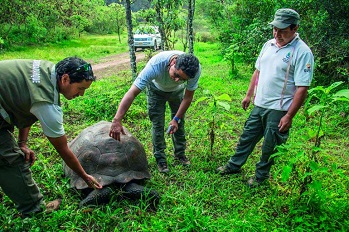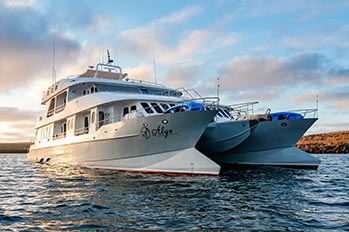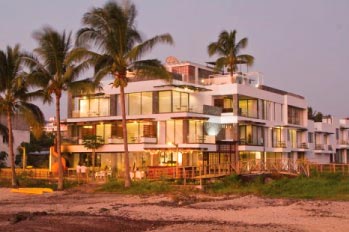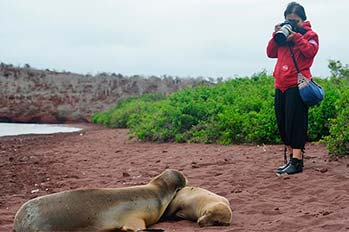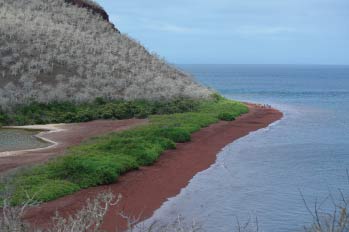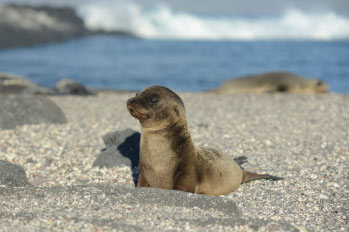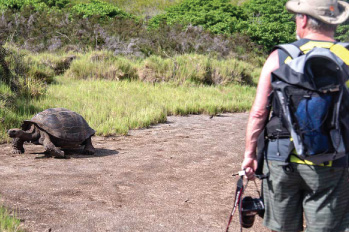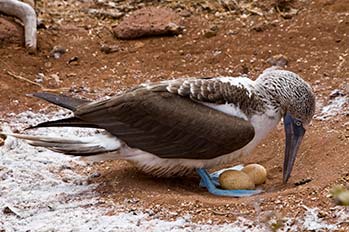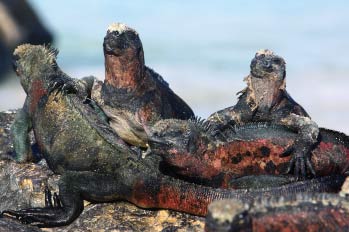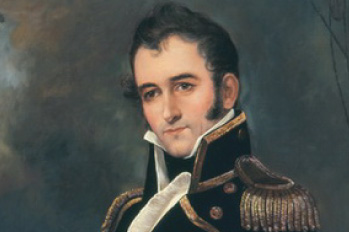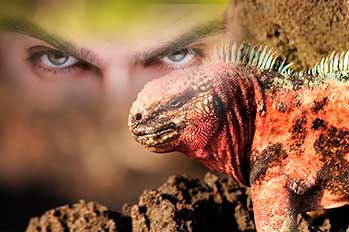What should you know before traveling to Galapagos?
In this section, you will find valuable and important information about the most amazing cruises sailing the Galapagos Islands, also the Galapagos facts such as weather, and the most interesting stories and activities in the Galapagos. You will find the most reliable hotels in the Islands where you can stay if you decide to take a land tour, as well as connectivity of how to arrive at this unique worldwide paradise and other things that will be very useful when visiting the Galapagos national park.
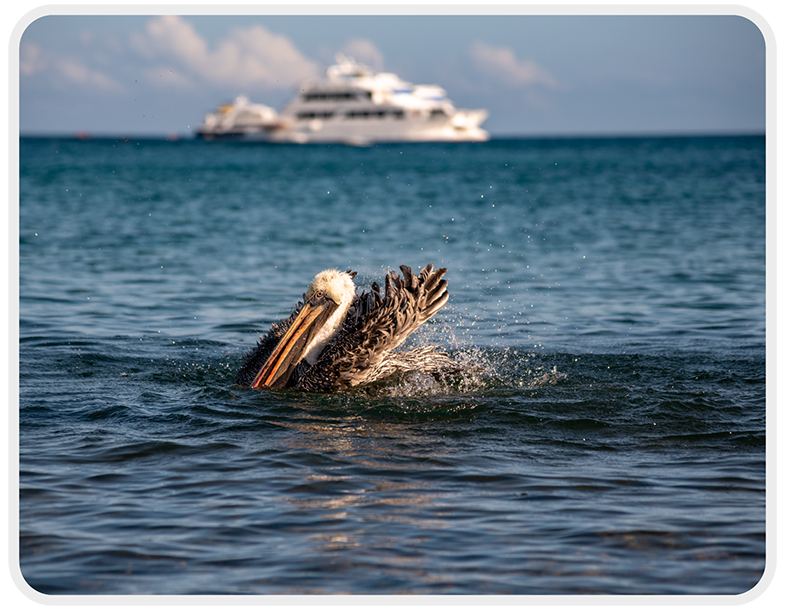
Important Information

Where are the Galapagos Islands?
The Galapagos Islands is a volcanic archipelago in the Pacific Ocean. It's considered one of the world's foremost destinations for wildlife-viewing. As part of Ecuador since 1832, the archipelago lies about 1,000km off its coast. Its isolated terrain shelters a diversity of plant and animal species, many found nowhere else. Charles Darwin visited in 1835, and his observation of Galapagos' species later inspired his theory of evolution.

Are Galapagos Islands protected?
The Galapagos National Park is within the System of Protected Areas of Ecuador, for whose purposes of sustainability the carrying capacity parameter is applied, considered in the National Park category for its 693,700 hectares, 96.7% is National Park and 3.3% remaining is colonized area.

How many islands are there in Galapagos?
The Galapagos Archipelago comprises seven major islands (Isabela, Santa Cruz, Fernandina, Santiago, San Cristóbal, Floreana and Marchena), it has 14 minor slands (Española, Pinta, Baltra, Santa Fe, Pinzón, Genovesa, Rábida, Seymour Norte, Wolf, Tortuga, Bartolomé, Darwin, Daphne Mayor and Plaza Sur), with 64 islets and 136 rocks have been counted.
CHECK AVAILABILITY IN REAL TIME AND QUOTE YOUR NEXT TRIP
Top 10 Places to visit in Galapagos
The Galapagos Islands are one of the best places to visit as is one of the top places recommended by Trip Advisor. The main reason why this destination has this tittle is among others its unique wildlife. Check out our recommended places worth it to be visited, whether it is for the animals, the activities or its history.
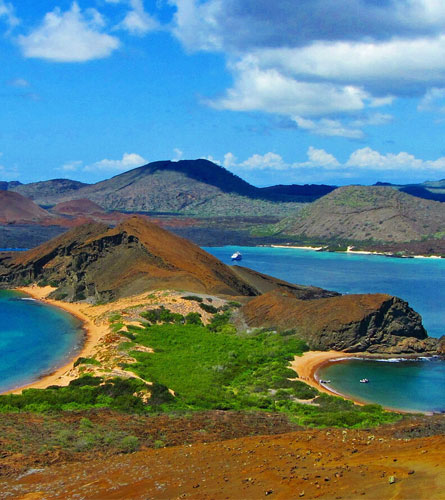
Bartolome
Bartolome is one of the most iconic places in the Galapagos and one of the few where you can see penguins without going to the remote areas of western Isabela and Fernandina. You will get great views of Pinnacle Rock, located in the northern side of the island, right next to a beautiful peach-color sand beach.
The hike to the top of the island is fantastic and will offer you incredible views of lunar landscapes with scattered volcanic cones. Many islands are visible from this outlook, as well as the bay of Sullivan and the Pinnacle rock.
- Snorkel: Clear and calm water, an incredible diversity of fish, colorful invertebrates, sea lions, turtles, rays and reef sharks.
- Highlights: Galapagos penguins, volcanic landscapes, Pinnacle rock, blue- footed boobies, herons, sea lions, sharks.
- Trail: 1,5 km / 0,9 mi
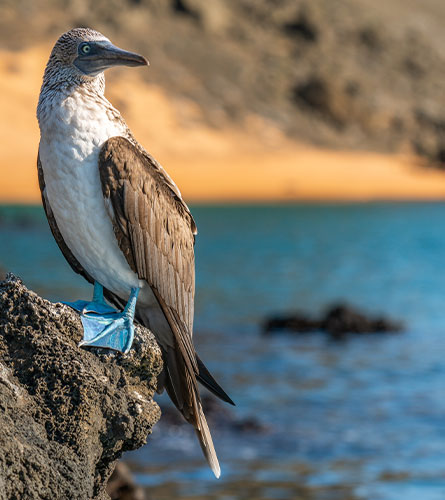
Suarez Point. Española
This rocky trail is one the most amazing nature walks you can do in the Galapagos islands.
From the moment you set foot on the island and all the way along the trail the amount and diversity of fauna is truly amazing. Sea lions and marine iguanas will be the first ones welcoming us, followed by large colonies of sea birds, including Nazca and Blue-footed boobies, gulls and tropicbirds. At the end of the trail we will visit a colony of waved albatross (April to January), the largest bird in the islands and one of the most interesting because of its powerful flight and elaborate courtship. Waved albatross only nest at Española, so this is the only place where you will see them at close range.
- Highlights: Sea lions, Waved Albatross, Galapagos hawks, Española mockingbirds, Darwin finches, marine iguanas, Nazca & Blue-footed Boobies, Red-billed Tropicbirds, Swallow-tailed gulls, herons, lava lizards, herons.
- Trail: 1,7 km / 1,1 mi
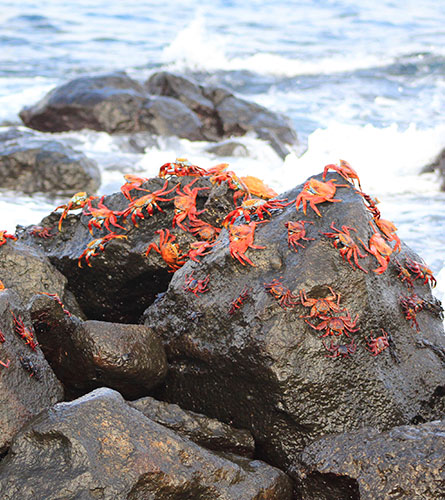
Espinosa Point. Fernandina
Located at the base of an imposing volcano (the most active in the Galapagos islands) this site is one of the jewels of the Galapagos National Park. As soon as you disembark you will be surrounded by hundreds of marine iguanas, as this is the largest colony for the species. Sea lions bask in the beaches while their pups play in tide pools. Along the shore you will see flightless cormorants, which are restricted to the western areas of the archipelago. Surrounded by cold plankton-rich waters, Punta Espinosa is home for an array of species, including herons, pelicans, oystercatchers, sea turtles, shorebird and many more. Look up in the mangroves as Galapagos hawks often perch to look for their prey.
- Snorkel: The nutrient-rich waters around Punta Espinosa attracts great numbers and diversity of fish and sea turtles. Seaweeds are also abundant, making this place the best for seeing marine iguanas feeding underwater. Following a cormorant underwater as it chases fish through the reef is one on the most amazing snorkel experiences you may have on your trip.
- Highlights: Galapagos hawks, marine iguanas, flightless cormorants, penguins, sea turtles, sea lions, herons, oystercatchers, shorebirds, sally light-foot crabs.
- Trail: 1,6 km / 1 mi

Gardner Bay. Española
Gardner beach is undoubtedly one of the most beautiful and interesting beaches to visit in the Galapagos. Its fine coral sand and turquoise water give it a totally tropical appearance, which contrasts with the presence of sea lions basking in the beach. You will have the opportunity to walk along the beach and learn about the biology of sea lions and other endemic species, such as the Española mockingbird, marine iguanas and Galapagos hawks.
- Snorkel: There are several great snorkeling places at Gardner bay. It is a fantastic site to swim with sea lions, reef sharks, rays and many species of fish, including; Angelfish, Parrotfish, Damselfish, Surgeonfish and many others.
- Highlights: Coral sand beach, sea lions, Galapagos hawks, Española mockingbirds, Darwin finches, marine iguanas.
- Trail: 0,8 km / 0,5 mi
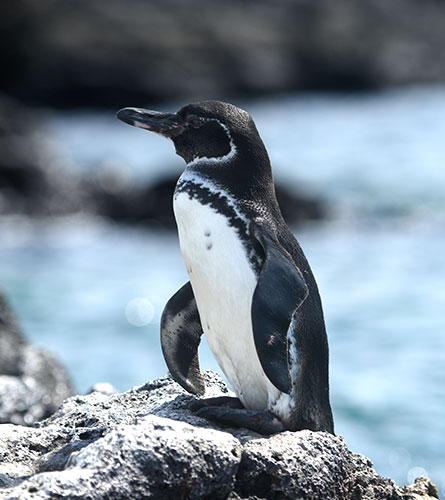
Elizabeth Bay. Isabela
Elizabeth Bay is a beautiful sheltered bay surrounded by large mangroves and barren lava fields. There is no trail here so you will take a dinghy tour to explore many channels, pools and coves teeming with life. This is one of the best locations in the islands to see Galapagos penguins, but don’t expect to see thousands of them, as the entire population of the islands is only about 3.000 of them. Flightless cormorants also nest in the area and blue-footed boobies and pelicans often fish in these shallow and rich waters. Rays and sea turtles are also very abundant.
- Highlights: Galapagos hawks, sea turtles, rays, Galapagos penguins, flightless cormorants, herons.
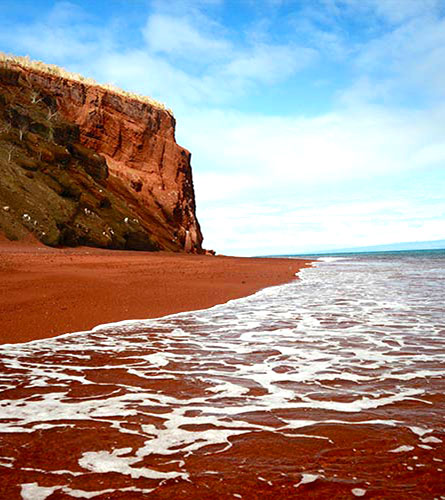
Rabida Islands
Rabida is a small island famous for its reddish lava rocks (rich in iron) which gives it a unique look. The beach is also red and hosts a small colony of sea lions. There is a small salt water lagoon where we will see ducks and stilts and sometimes flamingoes. The trail will take you inland to get beautiful views of the beach and the lagoon. Look for Darwin finches, flycatchers and mockingbirds. In the cliffs along the coast you can find Nazca & blue-footed boobies, brown noddy, herons and the two species of sea lions: Galapagos and fur seals.
- Snorkel: You can snorkel from the beach and explore a sheltered rocky area, which is excellent for fish, sea lions and reef sharks. Look at the high diversity of small invertebrates attached to the vertical walls.
- Highlights: Red-sand beach, Galapagos sea lions, Galapagos hawks, flycatchers, Darwin finches, Galapagos mockingbirds, ducks, flamingoes.
- Trail: 2 km / 1,2 mi
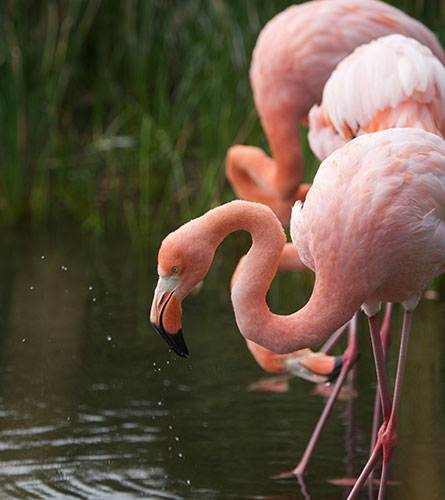
Cormorant Point / Devil’s Crown. Floreana
Punta Cormorant is located in the north of Floreana and it is known for its large coastal lagoon with American flamingoes, white-cheeked pintails, black-necked stilts and other shorebirds. There is a beautiful white sand beach which is an important nesting ground for green sea turtles where we can also see rays and reef sharks. In the last years, a small groups of blue footed boobies have started to breed right by the trail. This is also a great trail to look at endemic plants.
- Snorkel: Current funnels plankton through the Crown, attracting huge schools of snapper, Creole fish parrot fish, angelfish, reef sharks, sea turtles, rays and a phenomenal amount of marine life.
- Highlights: American flamingo, blue-footed booby, frigatebirds, tropicbirds, Galapagos shearwaters, sea lions, sea turtle nesting site, finches, shorebirds, coral-sand beach.
- Trail: 1,6 km / 1 mi
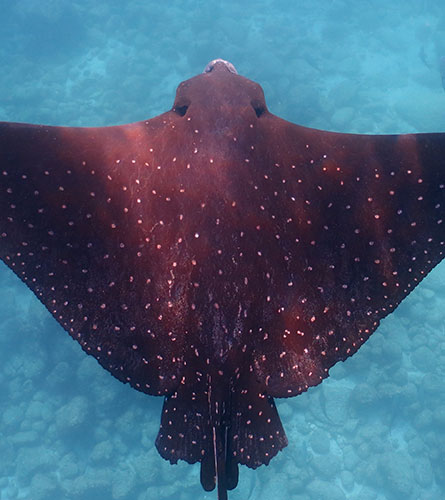
Vicente Roca Point. Isabela
Surrounded by some of the tallest cliffs in the Galapagos, Vicente Roca point is a great location to observe spectacular landscapes and interesting volcanic features. There is no trail here but you will take a dinghy tour along the shore to get a closer view of pelicans, flightless cormorants, sea turtles, boobies, Galapagos fur seal and marine iguanas. The area is also known to be a good location for whales and dolphins.
- Snorkel: Snorkel in the cove to look for sea turtles, penguins, sea lions, cormorants, rays and many different species of fish. Look for fan corals, sponges and other invertebrates growing on the walls.
- Highlights: Marine iguanas, flightless cormorants, penguins, sea turtles, fur seals, Nazca & blue-footed boobies

Urbina Bay. Isabela
This place is known for the dramatic uplifting that happened here during the 1950’s. A large portion of the coast was pushed up, exposing many hectares of previously submerged land. Look carefully along the trail and you will find small shells and corals, a proof that the area was underwater more than sixty years ago. The trail will give the opportunity to see land iguanas and, during certain seasons, giant tortoises. Galapagos hawks nest in the area and are often seen flying or perched on the trees.
- Snorkel: You can snorkel from the beach to see sea turtles, cormorants and penguins. Fish are also abundant in the area.
- Highlights: Galapagos hawks, land iguanas, Galapagos hawks, Galapagos mockingbirds, Darwin finches, flycatchers.
- Trail: Short trail: 1,2 km / 0,7 mi. Long Trail: 3,0 km / 1,8 mi

Post Office Bay. Floreana
Floreana is famous for the tales of German settlers and the baroness during the late 1920’s and 30 ‘s. Assassinations, disappearances and other unsolved mysteries are the ingredients of this fascinating story.
Post office bay was often used by whalers to anchor their ships and go up to the highlands to get freshwater and tortoises. Most boats visiting the Galapagos had to came to this place sooner or later, so a system of mail was established more than 200 years ago: a barrel near the beach became the way to leave messages to other ships and also to the outside world. This mail system is still in use and will allow you to send postcards from the Galapagos to the outside world.
Aside from a small beautiful beach and a lava tunnel, the area is great for dinghy tours to look for sea lions, green sea turtles, shorebirds, small sharks and, with some luck, Galapagos penguins.
- Snorkel: There is great snorkel from the beach, as you can see lots of sea turtles, rays, great diversity of fish and, if you are really lucky, Galapagos penguin.
- Highlights: Sea Lions, sea turtles, finches, shorebirds, marine iguanas, penguins.
- Trail: 0,7 km / 0,4 mi


